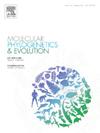Exploring genome architecture as a source of phylogenetic characters for resolving the apulmonate arachnid polytomy
IF 3.6
1区 生物学
Q2 BIOCHEMISTRY & MOLECULAR BIOLOGY
引用次数: 0
Abstract
Chromosome-level genome assemblies are powerful tools for identifying the presence of rare genomic changes that can overcome phylogenetically intractable problems. Chelicerata, the sister group to the remaining arthropods, harbors a soft polytomy at the base of an internal node named Euchelicerata, which is variably resolved across phylogenomic studies. As a result, seven orders, comprising horseshoe crabs and six apulmonate arachnid lineages, exhibit highly unstable placements from one study to the next, typically with maximal nodal support. Here, we analyzed recently released chromosome-level genomes of two of these orders, Opiliones (harvestmen) and Solifugae (camel spiders). We show that both Opiliones and Solifugae exhibit an unduplicated genome condition, as inferred from analysis of gene clusters, microRNAs, and macrosynteny. These results are congruent with phylogenomic studies that have refuted traditional morphological placements of Opiliones and Solifugae as close relatives of orders within Arachnopulmonata, a subset of six arachnid orders that are united by a shared whole genome duplication. Additionally, we examine irreversible chromosome fusion-with-mixing events as potential sources of phylogenetic data. We show that while fusion and mixing events are common in apulmonate arachnids, multiple mixing events support incompatible unrooted tree topologies. These results suggest that fusion and mixing events have evolved convergently in the chelicerate tree of life, particularly for extant lineages with a small number of chromosomes. Overall, our findings demonstrate that broader sampling of chelicerate genomes and establishment of genomic resources for key missing orders are essential to unlocking the potential of rare genomic changes as phylogenetic data sources.

探索基因组结构作为解决肺叶蛛形动物多裂的系统发育特征的来源。
染色体水平的基因组组装是识别罕见基因组变化存在的强大工具,可以克服系统发育上棘手的问题。Chelicerata是其余节肢动物的姐妹类群,在一个名为Euchelicerata的内部结的底部有一个柔软的息肉,这在系统基因组学研究中得到了不同的解决。结果,七个目,包括马蹄蟹和六个apulmonate蛛形纲,从一个研究到下一个研究,表现出高度不稳定的位置,通常是最大的节点支持。在这里,我们分析了最近公布的两个目的染色体水平的基因组,Opiliones(收割机)和Solifugae(骆驼蜘蛛)。我们发现,从基因簇、microrna和宏观同步分析推断,Opiliones和Solifugae都表现出不重复的基因组状况。这些结果与系统基因组学研究一致,这些研究驳斥了传统的形态定位,即Opiliones和Solifugae是Arachnopulmonata目的近亲,Arachnopulmonata目是由共享的全基因组复制联合起来的六个蛛形纲的一个子集。此外,我们研究了不可逆的染色体融合混合事件作为系统发育数据的潜在来源。我们表明,虽然融合和混合事件在apulmonate蛛形纲中很常见,但多个混合事件支持不兼容的无根树拓扑结构。这些结果表明,在螯合生物树中,融合和混合事件是趋同进化的,特别是对于现存的染色体数量较少的谱系。总的来说,我们的研究结果表明,更广泛的螯合基因组采样和建立关键缺失序列的基因组资源对于释放罕见基因组变化作为系统发育数据源的潜力至关重要。
本文章由计算机程序翻译,如有差异,请以英文原文为准。
求助全文
约1分钟内获得全文
求助全文
来源期刊
CiteScore
7.50
自引率
7.30%
发文量
249
审稿时长
7.5 months
期刊介绍:
Molecular Phylogenetics and Evolution is dedicated to bringing Darwin''s dream within grasp - to "have fairly true genealogical trees of each great kingdom of Nature." The journal provides a forum for molecular studies that advance our understanding of phylogeny and evolution, further the development of phylogenetically more accurate taxonomic classifications, and ultimately bring a unified classification for all the ramifying lines of life. Phylogeographic studies will be considered for publication if they offer EXCEPTIONAL theoretical or empirical advances.

 求助内容:
求助内容: 应助结果提醒方式:
应助结果提醒方式:


